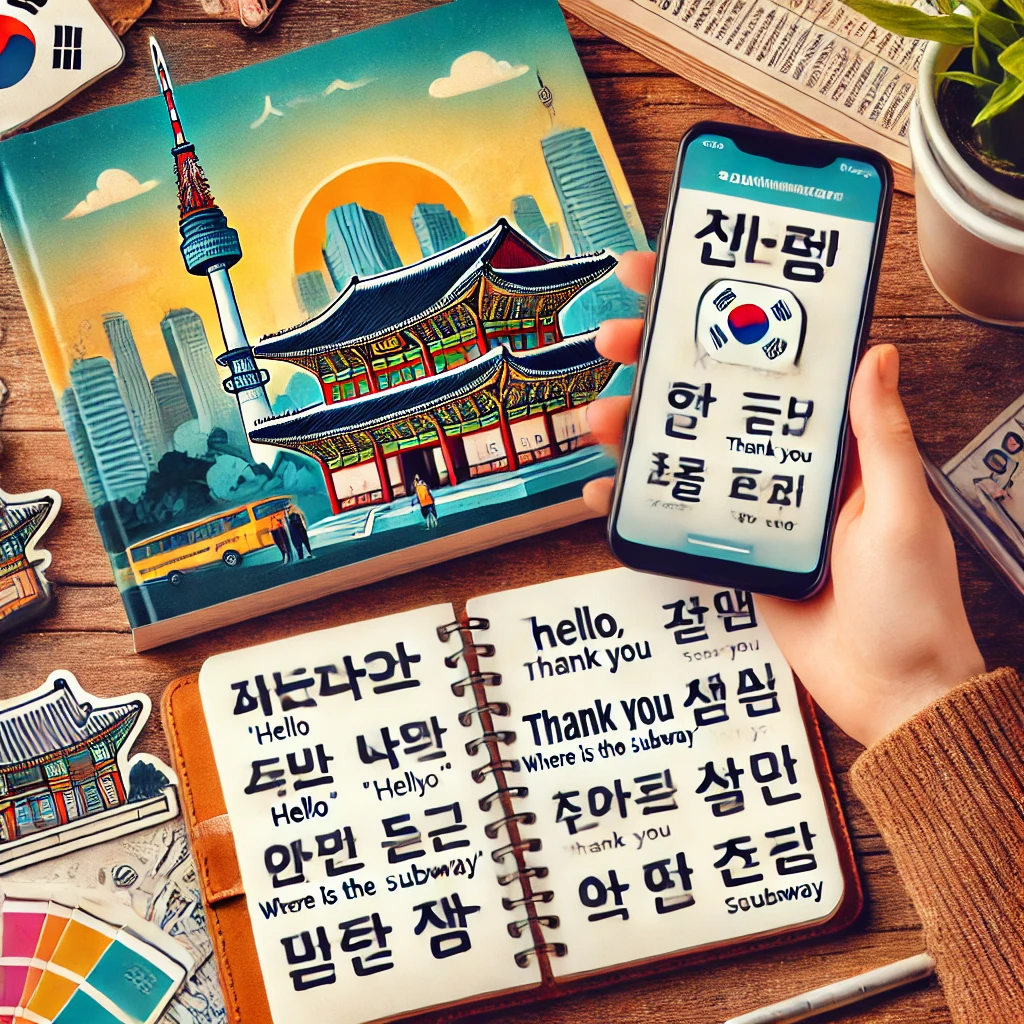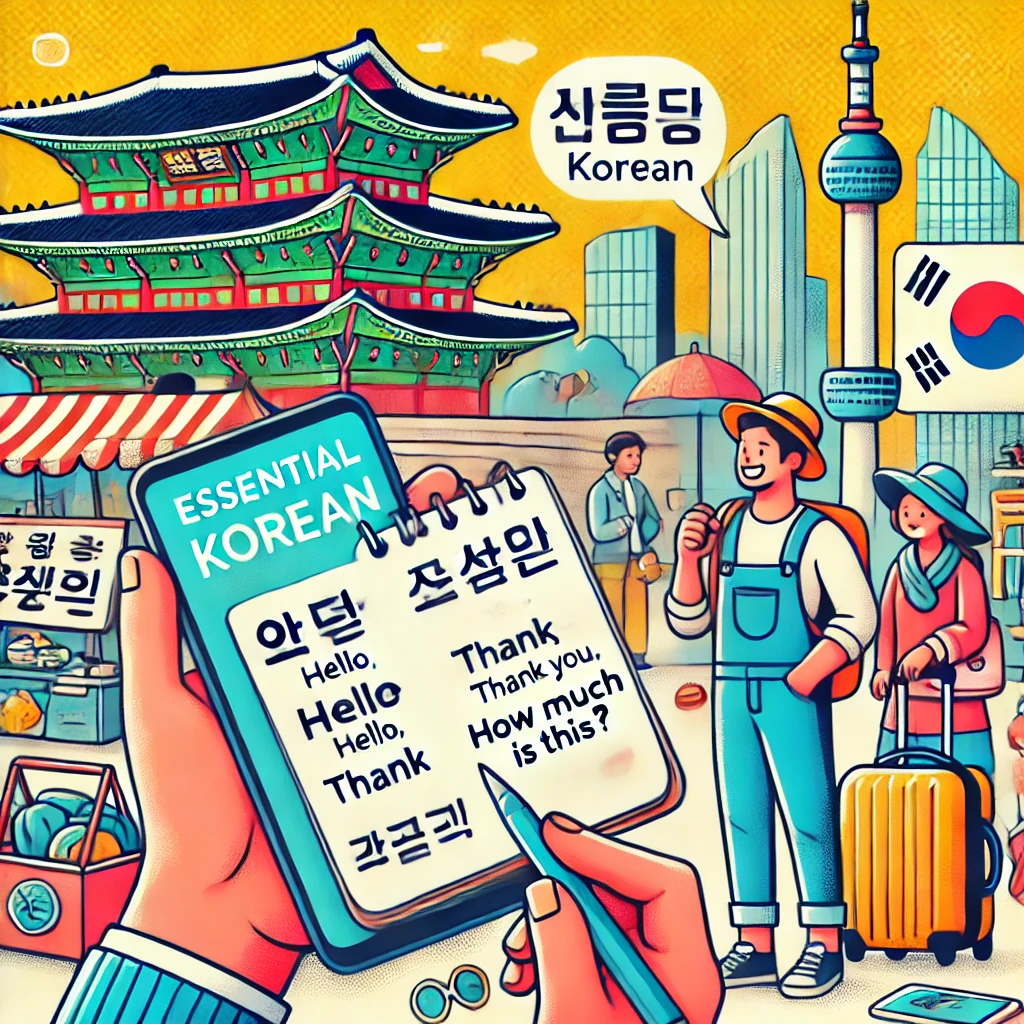Table of Contents
Introduction to Korean Language Basics
The Korean language, known as Hanguk-eo, is a fascinating linguistic system that captivates many due to its unique structure and rich cultural significance. The primary script used in writing Korean is Hangul, which was developed in the 15th century and boasts scientific efficiency. Hangul consists of 14 initial consonants and 10 vowels, allowing for straightforward syllable construction. For American travelers, familiarizing themselves with this alphabet is beneficial, as it forms the basis for understanding pronunciation and meaning in the language.
Pronunciation in Korean differs significantly from English, making it essential for travelers to grasp basic sounds. Notably, some Korean sounds do not have direct equivalents in English, potentially leading to miscommunication if pronunciation is neglected. For instance, the Korean “ㄹ” can sound like an “l” or an “r” depending on its placement in a word, which can be challenging for non-native speakers to master. Therefore, a gentle introduction to these phonetic nuances will greatly aid travelers in their communication with locals.
Learning basic Korean phrases can significantly enhance the travel experience in South Korea. It demonstrates respect toward the local culture, fosters cordial interactions, and facilitates navigation in diverse situations, such as dining, shopping, or seeking directions. Familiarizing oneself with simple conversational phrases, greetings, and expressions of gratitude can create an opportunity for deeper connections with locals, promote cultural understanding, and enrich the overall travel journey. Investing time to learn these essential phrases not only aids in practical communication but also contributes to a more immersive experience, making one’s trip to Korea truly memorable.

Getting Started: Essential Greetings
When traveling to Korea, knowing essential greetings can greatly enhance the experience and facilitate interactions with locals. The first phrase to master is “안녕하세요” (annyeonghaseyo), which means “hello.” This versatile greeting can be used at any time of the day and is appropriate when addressing someone you meet for the first time or in everyday situations.
Another crucial phrase is “감사합니다” (gamsahamnida), translating to “thank you.” Expressing gratitude is an important aspect of Korean culture, and using this phrase will undoubtedly endear you to the locals. It is often used after receiving services, such as dining in a restaurant or receiving assistance from staff.
A polite way to say goodbye is “안녕히 가세요” (annyeonghi gaseyo), which is said when someone is leaving. Conversely, if you are the one departing, you can use “안녕히 계세요” (annyeonghi gyeseyo) to wish those staying behind well. Both phrases reflect the respect and courtesy prevalent in Korean social interactions.
In addition to greetings, the word “제발” (jebal) translates to “please.” This word can be used when making requests, showing politeness while interacting with others. Adding “제발” before your requests can ensure they are received positively.
The phonetic spellings provided allow travelers to practice pronunciation easily and use these essential greetings when exploring South Korea. Utilizing such simple yet effective phrases will not only assist in day-to-day interactions but also demonstrate cultural respect, paving the way for a more memorable trip.
Ordering Food: Key Phrases for Dining
When traveling in Korea, one of the most significant aspects of the experience is indulging in the rich, diverse culinary landscape. To enhance your dining experience, mastering a few essential phrases can make a substantial difference. Firstly, to ask for a menu, you can say, “메뉴 주세요” (menyu juseyo), which translates to “Please give me the menu.” This phrase is polite and shows respect when interacting with restaurant staff.
If you’re unsure about what to order, requesting recommendations can be beneficial. You might say, “추천해 주세요” (chucheon hae juseyo), or “Please recommend something.” This approach not only opens up the conversation but also allows locals to guide you toward delicious dishes that you might not have considered otherwise.
For those with dietary restrictions, communicating your needs is crucial. If you are vegetarian, you can say, “저는 채식주의자예요” (jeoneun chaesikjuuija-yeyo), meaning “I am a vegetarian.” In case of allergies, it is vital to mention specific ingredients. For example, “이것에 땅콩이 있나요?” (igeose ttangkongi innayo?), which means “Does this contain peanuts?” This ensures that your meal aligns with your dietary preferences, contributing to a more enjoyable culinary experience.
Additionally, familiarizing yourself with common food vocabulary will aid in navigating menus more effectively. Some useful terms include “밥” (bap – rice), “고기” (gogi – meat), and “채소” (chaeso – vegetables). Understanding these words can help you make informed choices while dining out.
Etiquette is also an essential aspect of dining in Korea. It is customary to wait for the eldest person at the table to begin eating first, and when using chopsticks, it is polite to avoid sticking them upright in rice, as this resembles a funeral ritual. By integrating these phrases and cultural nuances, you will enhance your overall dining experience in Korea.
Navigating Transportation: Useful Terms for Travelers
When traveling in South Korea, mastering some essential phrases related to transportation can significantly enhance the experience. Knowing how to ask for directions or understanding public transit routes can alleviate the stress often associated with navigating new cities. For instance, if you find yourself lost, a simple, “저기요, 길 좀 물어봐도 돼요?” (Excuse me, can I ask for directions?) can open the door to assistance from locals. In addition, asking “어디에요?” (Where is it?) can help when you’re trying to identify your desired destination.
Purchasing tickets for public transport is another area where language skills can be beneficial. Common phrases to know include “이거 주세요” (I would like this) when pointing to a ticket, or “얼마예요?” (How much is it?). Familiarizing oneself with terms specific to transportation can ease this process, such as “지하철” (subway) and “버스” (bus). A basic understanding of the public transit system will also assist in navigating the various routes. Knowing the phrase “이 노선으로 가고 싶어요” (I want to go on this route) can be effective when communicating with staff or drivers.
Taxi rides present additional opportunities for communication. To ensure a smooth journey, always carry your destination written down in Korean, especially if you are traveling to less-known areas. Informing the driver of your final location with phrases such as, “여기로 가주세요” (Please take me here) can minimize misunderstandings. Moreover, understanding the term “요금” (fare) is crucial to avoid confusion when it comes to the costs. In summary, developing a level of comfort with transportation-related phrases can transform what might be a challenging aspect of travel into a more enjoyable and effortless experience.
Shopping Essentials: Phrases for a Successful Bargain
Shopping in Korea can be an exciting experience, offering unique products and vibrant markets. To enhance this experience, it is beneficial to know some essential phrases that will empower you during your shopping endeavors. One of the most useful phrases when entering a shop is “이거 얼마예요?” (igeo eolmaeyo?), which translates to “How much is this?” This query helps you get immediate information on the price of an item, enabling you to make informed decisions.
Moreover, if you find an item that you like but are concerned about the price, it is perfectly acceptable to inquire about a possible discount. You can ask, “할인해 주세요?” (halin hae juseyo?), meaning “Can you give me a discount?” This phrase is especially handy in markets or small shops, where flexibility in pricing is more common.
It’s also important to know how to check for product availability, particularly if you are interested in a specific item. A useful phrase for this scenario is “이거 있어요?” (igeo isseoyo?), which means “Do you have this?” Knowing this will save you time and help in locating desired products quickly.
Additionally, understanding polite expressions can greatly enhance your shopping experience. For instance, you might say “감사합니다” (kamsahamnida) to express gratitude after a purchase. It’s beneficial to engage politely with shopkeepers, as it often leads to a more positive interaction.
With these phrases in your vocabulary, you will undoubtedly navigate through Korean markets and stores with greater ease and confidence. Remember, the key to a successful shopping experience lies in effective communication, which these phrases facilitate.In conclusion, mastering these essential shopping phrases will not only help you secure a good bargain but also enrich your overall travel experience in Korea.
Emergency Situations: Phrases for Safety
Traveling to a new country can be an exhilarating experience, but it is crucial to prepare for unforeseen circumstances. Knowing how to communicate in emergency situations is essential for any American traveler visiting Korea. Equipped with the right phrases, you can seek assistance, report a situation, or explain your medical needs, contributing to your overall safety and well-being during your journey.
One key phrase you should learn is “도와 주세요” (dowa juseyo), which translates to “Please help me.” This expression will be invaluable if you find yourself in a precarious situation or require immediate assistance. In the event of an accident, knowing how to describe your ailment becomes crucial. For instance, if you are feeling unwell, you can say “아프세요” (apeuseyo), meaning “I am in pain,” or specify your symptoms, such as “머리가 아파요” (meoriga apayo), which means “I have a headache.” These phrases can facilitate communication with healthcare professionals or locals willing to assist.
In emergencies involving theft or crimes, it is important to report the situation promptly. Phrases such as “경찰 부르세요” (gyeongchal bureuseyo) means “Call the police” and can be critical in summoning help. Furthermore, knowing how to specify an item that has been stolen, such as “내 지갑을 잃어버렸어요” (nae jigabeul ilh-eobeoryeosseoyo), which translates to “I lost my wallet,” can streamline the process of reporting incidents to authorities.
By familiarizing yourself with these emergency phrases, you empower yourself to manage unexpected events while traveling in Korea. It is advisable to practice these phrases so they become second nature, providing peace of mind and a greater sense of security. The ability to communicate effectively in emergencies significantly enhances your travel experience, ensuring you feel more confident and prepared. In conclusion, investing time to learn essential phrases for emergencies ensures a safer and more enjoyable trip to Korea.
Cultural Etiquette in Korean Communication
Understanding cultural etiquette is crucial for American travelers engaging with the Korean language. In South Korea, communication transcends mere words; it embodies respect and social hierarchy. One of the most notable aspects of this communication style is the practice of bowing. A slight bow is often employed as a greeting, as a sign of gratitude, or to express an apology. This gesture signifies respect and acknowledges the social dynamics at play in Korean society. Therefore, when meeting someone, taking a moment to bow can facilitate a more positive interaction.
Furthermore, addressing individuals appropriately is key in respecting Korean cultural norms. In Korea, the way you address others can convey your level of familiarity and respect. For instance, addressing someone with their title followed by their name demonstrates acknowledgment of their social status. Using honorifics, like – 씨 (ssi) after a person’s name, is essential unless you are specifically invited to use their first name. This focus on names and titles reinforces the importance of respectful communication in various social contexts.
Politeness is a fundamental aspect of conversations in Korea. Knowing when to use polite forms of speech can significantly enhance your interactions. For example, there are specific verb endings indicating a formal tone, which is crucial when speaking to elders or strangers. Using the casual form with close friends and family is acceptable, but opting for the polite level when unsure reflects a respectful attitude. Understanding these nuances helps build rapport with locals, and it demonstrates your willingness to adapt to their customs, fostering a more memorable travel experience.
Practice Makes Perfect: Learning Tips and Resources
As American travelers prepare for a trip to Korea, actively practicing essential Korean phrases can greatly enhance their communication skills and cultural experience. To facilitate this learning journey, several resources and strategies are available. One of the most effective methods is the use of language learning apps. Applications such as Duolingo, Memrise, or Rosetta Stone offer structured courses that cover basic vocabulary and essential phrases. These platforms are well-designed to make learning engaging and can be accessed anytime, allowing travelers to practice at their convenience.
Joining local language exchange groups is another excellent approach. Many cities have community centers or online forums, such as Meetup or Facebook groups, where individuals interested in language learning can connect. Engaging in conversations with native speakers not only helps in practicing speaking skills but also fosters a deeper understanding of cultural contexts and nuances of the language. It can also be beneficial to arrange one-on-one language exchanges with Korean speakers who wish to learn English; this mutually beneficial setup encourages both parties to improve their language skills.
Online resources, including free websites such as Talk To Me In Korean, offer comprehensive lessons ranging from beginner to advanced levels. These platforms include audio and visual aids to support learning, as well as quizzes to test comprehension. Moreover, incorporating media such as Korean films, music, and podcasts into the language learning process can provide immersive experiences that reinforce the vocabulary and phrases learned. This multifaceted approach to practicing Korean phrases will promote confidence in conversations during travel.
In conclusion, combining various resources, such as language learning apps, exchange groups, and online platforms, along with engaging with Korean media, will equip travelers with the necessary skills to communicate effectively during their trip to Korea.
Conclusion: Embrace the Korean Experience
Learning essential Korean phrases greatly enhances the travel experience for American visitors to South Korea. While navigating through this vibrant country, the ability to communicate even at a basic level allows travelers to connect more deeply with the locals. By picking up key phrases such as greetings, expressions of gratitude, and common inquiries, travelers not only facilitate smoother interactions but also demonstrate respect for the culture and its people. This linguistic effort can lead to memorable encounters, whether it involves communicating with shopkeepers, dining at restaurants, or asking for directions.
Additionally, understanding the language serves as a gateway to cultural appreciation. Language is more than a mere tool for communication; it is an embodiment of values, traditions, and ways of life. Familiarity with Korean phrases can inspire travelers to explore more about South Korea’s rich history, unique customs, and delectable cuisine. When visitors engage in conversations with locals using their language, it often results in warmer receptions and richer exchanges. These experiences transcend the typical tourist interactions, creating a more authentic and meaningful journey.
Moreover, learning phrases can also pave the way for building friendships and genuine connections. Koreans often appreciate when foreigners attempt to learn their language, as it represents an acknowledgment of their culture. As travelers delve into the language and culture, they unlock deeper insights and stories about the places they visit. Therefore, embracing the Korean experience goes beyond mere sightseeing; it involves engaging with the people and understanding their way of life through language. Ultimately, the effort invested in learning essential Korean phrases enriches the travel experience, creating lasting memories and fostering a bridge of understanding between cultures.





